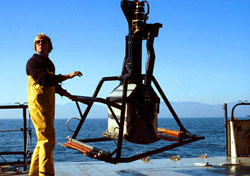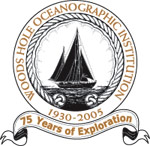This is an archived site. This site is no longer being maintained or reviewed for broken links.
Employee Portrait Gallery—Jim Broda
 |
|
|
Jim Broda recovers a box corer aboard Knorr during a Black Sea cruise in 1988. |
|
With a 1970 bachelor’s degree from Penn State in mineral economics, Jim Broda landed a job as a chef downcape. He learned about WHOI, visited then personnel manager Bruce Crawford, and went off to Vermont to cook at Killington for the winter. Next thing he knew, he was hauling carboys of secondarily treated effluent from Rhode Island for John Ryther’s aquaculture project to nourish shellfish with plankton grown in seawater and sewage. In 1973, Jim moved to the Geology & Geophysics Department and joined his first cruise, a six-month expedition in the South Atlantic aboard Chain. Since then he has been involved in designing a number of important tools for collecting data from the seafloor. He was principal engineer for large-diameter piston coring systems that are installed on WHOI vessels as well as on three U.S. Coast Guard icebreakers, Lamont’s Ewing, and NSF’s Palmer. Over a recent four-year period, he traveled each spring to Lake Titicaca, high in the Andes, to collect seismic data and long cores from a reborn 38-foot-long vessel donated by USGS. Intriguing design projects Jim has worked on include development of NOBEL (Near Ocean Bottom Explosive Launcher). After more than 40 years of studying the earth beneath the sea using surface explosives and towed receivers, scientists began to deploy on-bottom receivers in the early 1980s. NOBEL’s team put the explosive source (48 high-energy charges, up to 22 pounds each) on the seafloor with the receivers for the first time. Making explosives work reliably at 15,000 feet was, as Jim put it, “a Blast!” R/V Knorr is undergoing a major structural refit for his current project, a 30,000-pound coring device that will capture samples up to 165 feet long. After 90 cruises, Jim says he still enjoys the experience of being on the ocean, which thoroughly modifies many aspects of daily life—and offers the added bonus of the opportunity to collect excellent data for future sea stories.
[back]

